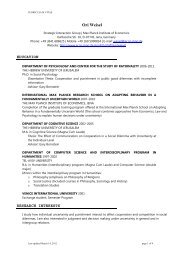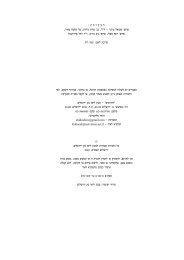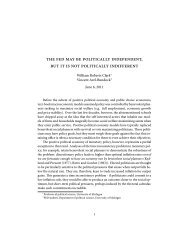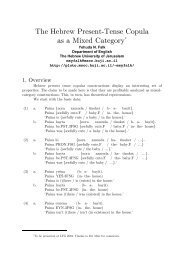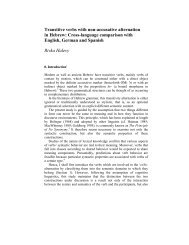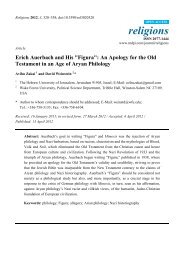View - Pluto Huji Ac Il
View - Pluto Huji Ac Il
View - Pluto Huji Ac Il
Create successful ePaper yourself
Turn your PDF publications into a flip-book with our unique Google optimized e-Paper software.
A Selection Bias Conflict and Frequentist Versus<br />
Bayesian <strong>View</strong>points ∗<br />
Micha Mandel<br />
The Hebrew University of Jerusalem, Israel, 91905<br />
and<br />
Yosef Rinott<br />
The Hebrew University of Jerusalem, Israel, 91905<br />
and LUISS Rome, Italy<br />
May 21, 2009<br />
∗ Micha Mandel is Lecturer, Department of Statistics, The Hebrew University, Jerusalem 91905, Israel<br />
(email: msmic@huji.ac.il) Yosef Rinott is Professor, Department of Statistics and Center for the Study of<br />
Rationality, The Hebrew University, Jerusalem 91905, Israel (email: rinott@mscc.huji.ac.il), and LUISS,<br />
Rome. The work of Yosef Rinott was partially supported by Israel Science Foundation grant 473/04. We<br />
thank Ester Samuel-Cahn, Daniel Yekutieli, Manor Askenazi, and Marco Scarsini for helpful conversations<br />
on the topic of this paper. We also thank the Editor the Associate Editor and a Referee for their thoughtful<br />
comments and suggestions.
Abstract<br />
In many branches of modern science, researchers first study or mine large data<br />
sets, and then select the parameters they estimate and the data they use and publish.<br />
Such data-based selection complicates formal statistical inference. An example<br />
discussed here for the purpose of illustration, is that of pharmaceutical companies<br />
that typically conduct many experiments but may publish only selected data. The<br />
selection often depends on the outcomes of the experiments since naturally there is<br />
interest in potentially useful drugs, and it is in general unclear how it should affect<br />
inference. Is this effect the same for the company and the public? Does it matter<br />
if they are Bayesian or Frequentist? Should the company reveal all experiments it<br />
conducts, and if so, how should this change the conclusions?<br />
This note discusses these questions in terms of a simple example of a sequence<br />
of binomial experiments conducted by a pharmaceutical company, where results are<br />
published only if the number of ‘failures’ is small. We do not suggest that this example<br />
corresponds to reality in the pharmaceutical industry, nor in science in general; our<br />
goal is to elaborate on the importance and difficulties of taking selection into account<br />
when performing statistical analysis.<br />
KEYWORDS: confidence interval, credible set, Binomial model, decision theory, meta<br />
analysis, publication bias
1 INTRODUCTION<br />
A recent paper by Psaty and Kronmal (2008) summarizes the events that led the pharmaceutical<br />
company Merck & Co., Inc. to withdraw the drug Rofecoxib (trademark Vioxx)<br />
from the market. The paper provides an extraordinary opportunity to compare the internal<br />
analyses of a pharmaceutical company to the reported analyses, and it exemplifies well<br />
the concerns appearing in Psaty and Kronmal’s abstract that Sponsors have a marketing<br />
interest to represent their products in the best light. This approach conflicts with scientific<br />
standards that require the symmetric and comparable reporting of safety and efficacy data.<br />
Selective reporting of the results of clinical trials can misrepresent the risk-benefit profile of<br />
drugs.<br />
This conflict of interests triggered editors of leading medical journals to announce that<br />
they would refuse to publish drug research sponsored by pharmaceutical companies unless<br />
the studies are registered in a public database from the outset. This initiative was reported<br />
in an article in the Washington Post on Sept 10 2004 (http://www.smh.com.au/articles/2004/09/09/<br />
1094530773888.html). The article explains the logic of this act by pointing out that More<br />
than two-thirds of studies of anti-depressants given to depressed children, for instance, found<br />
the medications were no better than sugar pills, but companies published only the positive<br />
trials. If all the studies had been registered from the start, doctors would have learned that<br />
the positive data were only a fraction of the total. For earlier references that suggest the<br />
creation of registries of research studies in connection with selection and meta analysis, see,<br />
for example, Iyengar and Greenhouse (1988) and references therein.<br />
More generally, it is well known that scientists and scientific journals tend to submit<br />
and publish significant results, while the existence of other results remains unknown. This<br />
problem, known as publication bias (Rothstein, Sutton, and Borenstein 2005), is similar<br />
to problems that arise in models having a large number of parameters (e.g., DNA and<br />
similar data), where inference is published only on a few parameters selected by the data,<br />
usually on those corresponding to the ‘statistically significant’ findings. However, methods<br />
for controlling error probabilities in multiple testing and estimation (e.g., Benjamini and<br />
Yekutieli 2005) require data which due to selection is not published. Iyengar and Greenhouse<br />
(1988) and Cleary and Casella (1995) provide a truncation model formulation that<br />
has many common features with the present paper, and certain solutions to the publication<br />
bias problem under specific assumptions, as well as numerous references.<br />
The purpose of this paper is to shed some light on the difficulty of trying to take data<br />
selection or publication bias into account, and the dangers of not doing so, by means of a<br />
very simple binomial example. We formulate our discussion in terms of a conflict between<br />
a pharmaceutical company and a regulator in Phase I studies, only as an illustration of a<br />
conflict of interests that may arise in the presence of selection bias. We do not claim to<br />
know how severe this conflict is in reality. Furthermore, Phase I clinical trials are followed<br />
by Phase II and Phase III studies, which provide certain control over the drugs or doses<br />
selected in Phase I.<br />
In Section 2 we explain why in certain situations, selection bias implies that frequentist<br />
confidence intervals of a given level are constructed differently according to the possibly<br />
conflicting points of view of the company performing the study and the public that uses<br />
them. Section 3 approaches the problem created by this selection bias conflict using the<br />
Bayesian paradigm. Although Bayesian analysis is post-data in nature, it can solve the<br />
difficulties of selection bias appearing in the frequentist paradigm only under rather spe-<br />
1
cial and questionable assumptions discussed in Section 3. Section 4 extends the selection<br />
criterion of Sections 2 and 3, and Section 5 concludes with a comparative discussion of frequentist<br />
and Bayesian analyses under publication bias. It also discusses the ability of the<br />
aforementioned initiative of registering studies in a public database to solve the concerns<br />
that arise by selection of results.<br />
2 A BINOMIAL MODEL<br />
Pharmaceutical companies perform Phase I toxicity studies on drugs and doses on a regular<br />
basis in order to screen out drugs that have significant adverse effects. Because of competition,<br />
they disclose only the minimum information necessary to get their drugs approved.<br />
The mission of public agencies such as the FDA is to ensure that approved drugs are indeed<br />
safe for use.<br />
Consider such a pharmaceutical company and suppose that for each experiment it conducts,<br />
the company statistician computes a confidence interval for θ, the probability of<br />
an adverse reaction to the drug. Each interval is based on the number of toxic cases in<br />
the given experiment, which is a Binomial random variable X ∼ Bin(n, θ), where n is the<br />
number of patients in the experiment, assumed fixed.<br />
Typically, there is a maximal probability of adverse reaction, θ M , corresponding to the<br />
Maximum Tolerated Dose (MTD), which is the maximal value of θ acceptable for a given<br />
disease. A drug would be accepted if all values in a computed confidence interval lie below<br />
θ M . For severe diseases, such as certain types of cancer, this value may be up to θ M = 0.2<br />
or 0.25.<br />
There are several methods for constructing 1−α level confidence intervals for θ, see, e.g.,<br />
Brown, Cai and DasGupta (2001) for a review. Here we consider the conservative method<br />
of Clopper and Pearson (1934) that, for X = x, solves for θ the equations Pθ(X ≥ x) = α/2<br />
and P θ (X ≤ x) = α/2 and defines the confidence interval CP (X) = [θ , θ ]. The function<br />
Pθ(X ≤ x) is decreasing in θ so that multiple solutions do not exist. However, for x = 0,<br />
the first equality has no solution and the interval uses 0 as its left limit. Likewise, for<br />
x = n, the right limit of the interval is 1.<br />
For example, for n = 20 and α = 0.05, this yields for X = 7 the interval CP (7) =<br />
[0.1539, 0.5922]. The interval CP (7) includes high toxicity levels that under normal circumstances<br />
are not acceptable, hence the drug will not be approved. Here we consider a<br />
scenario in which drugs or doses associated with experiments resulting in such a high number<br />
of cases of adverse reactions are deemed useless by the company, and therefore such<br />
experiments are not disclosed to the public. Thus, only successful experiments, say with<br />
X ≤ c adverse reactions for some c, and their associated confidence intervals are published<br />
and no information on unsuccessful experiments, including their number and outcomes, is<br />
revealed. For simplicity, we first discuss the case of c = 1 . We elaborate on the choice of<br />
c in Section 4, where it is also shown that the main issues discussed below are not specific<br />
to a particular choice of this parameter.<br />
Continuing the example of n = 20 and α = 0.05, if c = 1 then only X = 0 or 1<br />
would be considered. The Clopper-Pearson intervals are CP (1) = [0.0013, 0.2487] and<br />
CP (0) = [0, 0.1684], possibly suggesting an acceptable level of toxicity.<br />
Suppose a regulator claims that the selection policy of the company distorts the results,<br />
and, however large θ is, the outcomes X = 0 or 1 will occur eventually. And so, the<br />
regulator says, in order to achieve good results, all the company has to do is to perform<br />
2
sufficiently many experiments. Therefore, he insists that published intervals should be<br />
computed on the basis of the random variable X ∗ having the distribution of X|X ≤ 1, i.e.,<br />
a Bernoulli variable with probability<br />
Pθ(X ∗ = 1) = Pθ(X = 1|X ≤ 1) =<br />
nθ<br />
1 + (n − 1)θ ≡ θ∗ (θ) ≡ θ ∗ . (1)<br />
For α < 1/2, it is easy to verify that a 1 − α level confidence interval for θ∗ is<br />
CI ∗ (X ∗ <br />
∗ [0, 1 − α] X = 0<br />
) :=<br />
[α, 1] X∗ = 1 ,<br />
an interval satisfying Pθ(CI ∗ (X ∗ ) ∋ θ ∗ ) ≥ 1 − α for all possible values of θ. For X ∗ = 0<br />
and X ∗ = 1, CI ∗ (X ∗ ) is equivalent to 0 ≤ θ ∗ (θ) ≤ 1 − α, and α ≤ θ ∗ (θ) ≤ 1, respectively.<br />
Rearrangement as intervals for θ yields confidence intervals denoted by CI(X ∗ ), which for<br />
X ∗ = 0 and 1 are<br />
CI(0) =<br />
<br />
0,<br />
1 − α<br />
<br />
<br />
, CI(1) =<br />
αn + 1 − α<br />
α<br />
(1 − α)n + α<br />
(2)<br />
<br />
, 1 . (3)<br />
Thus, the resulting regulator’s confidence intervals are (for n = 20, α = 0.05): CI(0) =<br />
[0, 0.4872] and CI(1) = [0.0026, 1]; they are strikingly different from those of the company<br />
statistician. The regulator can claim that the data prove nothing, since for X ∗ = 1, the<br />
confidence interval covers almost the whole range [0, 1], and for X ∗ = 0 the probability<br />
of adverse reaction could be almost as high as 0.5, a level that could never be tolerated.<br />
Thus the company may claim that all published experiments indicate an acceptable level of<br />
toxicity, whereas the regulator claims that the published data lead to no such conclusions.<br />
In general, as n increases, the interval CI(1) includes large values of θ and becomes<br />
wider, eventually approaching [0, 1]. This may surprise a reader who expects that one<br />
success out of n indicates a small θ. However, taking the selection criterion X ≤ 1 into<br />
account, the result is not surprising: for θ > 0 and increasing n, an outcome of X ∗ = 1<br />
occurs with probability approaching 1, and hence it is hardly informative, resulting in a<br />
large confidence interval that contains 1, rather than proving a small θ. The interval CI(0)<br />
equals [0, 1 − α] for n = 1 and its upper limit decreases with n, as expected. Thus, for<br />
large n, an experiment that results in 0 adverse reactions may indeed prove the safety of<br />
the treatment even to the regulator. However, under commonly acceptable values of θ, the<br />
probability of 0 adverse reactions, that by (1) is bounded by 1−θ,<br />
becomes small rather fast<br />
nθ<br />
as n increases.<br />
In order to better understand the differences and the conflict between the company<br />
and the regulator, we consider the following probabilistic model. Let θ = (θ1, θ2, . . .) be a<br />
sequence of probabilities 0 < θi < 1, and let Xi ∼ Bin(n, θi), i = 1, 2, . . ., be independent<br />
binomial experiments. Let T0 = 0 and define successively Tj = min {i > Tj−1 : Xi ≤ 1},<br />
j = 1, 2, . . ., the indices of ‘successful’ experiments; we assume that θ is such that Pθ(Tj <<br />
∞) = 1 for all j.<br />
The company statistician computes a confidence interval for each θi such that,<br />
Pθ(CP (Xi) ∋ θi) ≥ 1 − α for all θ ∈ (0, 1) ∞ . (4)<br />
This guarantees (see Berger 1985 pp 22-23) lim infN→∞ N −1 N<br />
i=1 I{CP (Xi) ∋ θi} ≥ 1 − α<br />
with probability 1, for all θ ∈ (0, 1) ∞ , where I{E} is the indicator of the event E. For<br />
3
α = 0.05, for example, it can be loosely interpreted as a rule that in the long run allows<br />
5% of all intervals, published or not, to miss the target parameters. Thus, the company<br />
uses a criterion that concerns all intervals, but discloses only selected ones.<br />
The regulator is aware only of the experiments that are published, namely, the successful<br />
ones, and suggests the criterion<br />
Pθ(CI(XTj ) ∋ θTj ) ≥ 1 − α for all θ ∈ (0, 1)∞ , (5)<br />
that takes into account the distribution of the observations XTj . The regulator’s view is<br />
that the confidence intervals must reflect the selection made by the company.<br />
The conflict becomes very apparent if one imagines a dishonest company that repeats the<br />
same experiment with the very same dose (and hence the same θ) until a success (X ≤ 1)<br />
is obtained, and calculates confidence intervals ignoring the fact that the probability θ<br />
is the same in all experiments. For example, suppose that the true probability of a toxic<br />
reaction is θ = 0.25 so that the number of toxic cases follows a Bin(20, 0.25) law. Under this<br />
model, the probability of a successful experiment is 0.7520 + 20 × 0.25 × 0.7519 ≈ 0.0243,<br />
so that on average, for every 40 experiments performed, the company will achieve one<br />
successful experiment and publish its corresponding confidence interval. This published<br />
interval includes only θ values below 0.25 as we saw above.<br />
3 A BAYESIAN PERSPECTIVE<br />
Failing to agree on a frequentist confidence measure, the company and the regulator may<br />
consult the Bayesian school. The two sides of the conflict hope for a useful advice from a<br />
Bayesian, knowing that Bayesians, unlike frequentists, analyze the observed data regardless<br />
of the design (see Ferguson 1967 Chapter 7.2, and Berger 1985 Chapter 7.7 for a comprehensive<br />
discussion). A relevant example in our context is the Stopping Rule Principle in<br />
sequential analysis: the stopping rule [terminating the data collection] should have no effect<br />
on the final reported evidence about θ obtained from the data (Berger 1985 p. 502). This<br />
principle is espoused by Bayesians, but not necessarily by frequentists. A simple instance<br />
would be a sequence of N Bernoulli experiments which ends with one failure (see Lindley<br />
and Phillips 1976 for a similar example). A frequentist must know the experimental design:<br />
was N fixed in advance, or is it a Geometric random variable, whereas in Bayesian analysis<br />
the nature of N turns out to have no effect on the calculations.<br />
Returning to the sequence of toxicity experiments, let X denote the whole data and let<br />
Tj(x) = t be the index of the j-th successful experiment. For any prior Π of the sequence<br />
θ, it is easy to see that the posterior distribution of θTj |X = x is equal to the posterior of<br />
θt|X = x, and as above, the reason for stopping is irrelevant. Therefore, if the regulator and<br />
the company were to use the same data and agree on the prior model, then their inference<br />
for θTj<br />
would be the same in spite of the selection.<br />
However, in the situation considered here, the regulator and the company do not have<br />
the same data, hence their inferences may be different as they condition on different events.<br />
Indeed, here the regulator observes Xt only for those t such that Tj = t, whereas the<br />
company has the values of Xi for all i. Thus, the company should base its inference on<br />
θt|X = x, while the regulator should base his inference on θt|{XT1, XT2, . . .} .<br />
In what follows, we consider two extreme models for the joint distribution of θ, a<br />
model of independence and a model of strong dependence, in order to demonstrate how the<br />
4
implications of Bayesian inference on the company vs. regulator conflict may be sensitive<br />
to the choice of a prior.<br />
Independent Parameters. With the lack of better information on the dependence<br />
structure, a convenient though arguable assumption on the prior which we consider first is<br />
that θ1, θ2, . . . are independent identically distributed with a (marginal) prior law Π and<br />
density π. We also use the standard assumption that the experiments are designed so that<br />
X1, X2, . . . |θ are independent and Xi|θ ∼ Bin(n, θi).<br />
Under this model, Xi is sufficient for θi in the sense that P (θi ∈ I|X1 = x1, X2 =<br />
x2, . . .) = P (θi ∈ I|Xi = xi) for any interval I, and therefore the posterior of θt|X = x<br />
is equal to that of θt|Xt = xt. Hence, Bayesian inference of the regulator ought to be the<br />
same as that of the company (if they agree on the marginal prior Π), and it is unaffected<br />
by the selection of data and parameters.<br />
For example, for the widely used flat prior U(0, 1), the posterior is Beta(x+1, n−x+1)<br />
and the 95% equal-tails credible intervals for n = 20, are [0.0012, 0.1611] and [0.0117,<br />
0.2382] for X = 0 and X = 1, respectively. These intervals are quite similar to those<br />
obtained and published by the company statistician using the frequentist procedure above.<br />
Therefore, the company may be indifferent to whether the Frequentist or the Bayesian<br />
paradigm is adopted, and may prefer the latter simply because it solves the conflict with<br />
the regulator.<br />
Strong Dependence. The results of the previous model rely on the prior Π which<br />
assumes independence of the θi’s. Next we contrast the independence assumption with the<br />
extreme case in which θi ≡ θ for all i and θ ∼ Π. Such a model may be of interest to a<br />
suspicious regulator who aims to protect against a dishonest company that repeats the very<br />
same experiment until obtaining a successful result (this model is similar to that discussed<br />
at the end of Section 2).<br />
When θi ≡ θ for all i, there is exactly one draw from the prior distribution Π that<br />
determines the parameters of all the binomial experiments. For simplicity consider now<br />
inference based on X ∗ ≡ XT1 whose conditional probability P (X ∗ = 1|θ) is given in (1).<br />
The Bayesian 1 − α credible interval for θ is an interval I whose posterior probability<br />
P (θ ∈ I|X ∗ = x) = <br />
and<br />
I π(θ|X∗ = x)dθ = 1 − α.<br />
For Π = U(0, 1), the posterior distribution functions for X ∗ = 0 and X ∗ = 1 are<br />
Π(θ|X ∗ = 0) =<br />
θ<br />
0<br />
Π(θ|X ∗ = 1) =<br />
<br />
(1 − u) [1 + (n − 1)u]du<br />
<br />
[1 + (n − 1)v]dv<br />
= n log{1 + (n − 1)θ} − (n − 1)θ<br />
1<br />
(1 − v)<br />
0<br />
θ<br />
0<br />
<br />
nu [1 + (n − 1)u]du<br />
1<br />
0 nv<br />
<br />
=<br />
[1 + (n − 1)v]dv<br />
(n − 1)θ − log(1 + (n − 1)θ)<br />
,<br />
n log(n) − (n − 1)<br />
,<br />
n − 1 − log(n)<br />
(using v/(a + bv)dv = b −2 {bv − a log(a + bv)} + const). These distributions are depicted<br />
in Figure 1 together with the prior distribution. The limits of the 1 − α level equal-tails<br />
credible intervals are the solutions for θ of Π(θ|X ∗ = x) = α/2 and Π(θ|X ∗ = x) = 1−α/2,<br />
see Figure 1. For α = 0.05 and n = 20, these are [0.0029, 0.6982] and [0.0620, 0.9778] for<br />
X ∗ = 0 and 1, respectively. The intervals are considerably different from those obtained<br />
under the independence model above, and are much more similar to the confidence intervals<br />
of the frequentist regulator given after (3).<br />
5
CDF<br />
0.0 0.2 0.4 0.6 0.8 1.0<br />
0.0 0.2 0.4 0.6 0.8 1.0<br />
Figure 1: Distribution functions under the model θi ≡ θ for all i; n = 20: solid line - the prior U(0,1),<br />
dashed line - the posterior for X ∗ = 1, dotted line - the posterior for X ∗ = 0. The 95% equal-tails credible<br />
intervals are defined by the points where the posterior distributions cross the horizontal y = 0.025 and y =<br />
0.975 lines.<br />
If the company insists on a prior consisting of independent θi’s while the regulator<br />
assumes the same θ in all experiments, then the regulator and the company are in conflict.<br />
In fact, from the discussion in the previous section it is seen that the company and<br />
the regulator will have the same posterior distribution only when Xt is sufficient for θt.<br />
Thus, the Bayesian paradigm appears to solve the conflict only by imposing rather strict<br />
and questionable assumptions. Without such assumptions the conflict that arose under<br />
the frequentist paradigm remains unresolved. A similar phenomenon has been recently<br />
demonstrated by Senn (2008) for a normal model.<br />
It is shown in the Appendix that when θi ≡ θ the posterior distribution of θ given X ∗ is<br />
stochastically decreasing in n when observing either one or zero successes. This implies that<br />
smaller values of θ would be predicted as n increases. It is interesting to note that when the<br />
experiment results in one success, the posterior distribution is stochastically larger than<br />
the prior (see Figure 1), and converges to it; thus observing one success indicates to the<br />
Bayesian that θ is larger than initially believed. This is somewhat similar to the behavior<br />
of the confidence intervals of (3), whose limits decrease with n. The limiting behavior of<br />
the posterior, discussed in details in the Appendix, is somewhat similar to that observed<br />
by Cleary and Casella (1995), who study p-values under a Bayesian publication bias model<br />
with a flat prior.<br />
theta<br />
4 The General Binomial Case<br />
So far, we have examined the publication bias problem for general n, and the case c = 1,<br />
and gave numerical examples for n = 20. The following discussion is aimed at showing<br />
that the selected example of n = 20 and the selection criterion of X ≤ c = 1 is not a case<br />
of selection bias on our part. Indeed, the nature of the results does not depend on c or n.<br />
In this section we consider the regulator-company conflict only in frequentist terms; some<br />
6
Bayesian examples are given in the Appendix.<br />
Let us consider how a company might choose its selection criterion c. Suppose that<br />
a toxicity level of at most θ M = 0.25 is acceptable, as may be the case in drugs for<br />
cancer in progressive stages, and the company decides to publish only those treatments<br />
that are considered safe, that is, experiments whose right limit of the associated Clopper-<br />
Pearson confidence interval is smaller than 0.25. For a fixed n, the selection criterion of<br />
X ≤ c is determined by c = max{x : P0.25(X ≤ x) ≤ α/2}, i.e., the largest integer<br />
such that observing any X ≤ c gives rise to a confidence interval with right limit smaller<br />
than 0.25. For example, for α = 0.05 and n = 100, a simple calculation shows that<br />
CP (16) = [0.094, 0.247] and CP (17) = [0.102, 0.258], hence results are published by the<br />
company only if X ≤ c = 16. For the case of n = 20 mentioned above, this criterion gives<br />
c = 1.<br />
Being aware of the company’s policy, the regulator considers a published experiment<br />
X ∗ c as having the distribution of X | X ≤ c, and calculates a frequentist confidence interval<br />
by<br />
CIc(x) = {θ : α/2 ≤ Pθ(X ∗ c ≤ x)} ∩ {θ : α/2 ≤ Pθ(X ∗ c ≥ x)}. (6)<br />
For a fixed n, this is indeed an interval as Pθ(X ∗ c ≤ x) can be shown to be non-increasing<br />
in θ (see Appendix A), and for X ∗ c = x, the left and right limits are the solutions for θ<br />
of the equations Pθ(X ∗ c ≥ x) = α/2 and Pθ(X ∗ c ≤ x) = α/2, respectively. As in the<br />
Clopper-Pearson intervals, the left limit for X ∗ c = 0 is 0 and the right limit for X ∗ c = c is 1.<br />
Since Pθ(X ∗ c ≤ x) = Pθ(X ≤ x)/Pθ(X ≤ c) > Pθ(X ≤ x) for all θ and c < n, the right<br />
limit of the confidence interval CIc(x) is always larger than the right limit of the Clopper-<br />
Pearson interval CP (x) that does not take selection into account. Thus, it may well happen<br />
that the company’s intervals are below θ M = 0.25, say, whereas the regulator’s intervals<br />
contain values larger than θ M . The disagreement on the right limit of the confidence<br />
interval is clear-cut when x = c. In this case, by the choice of c, the company’s confidence<br />
interval has a right limit < θ M = 0.25, whereas the regulator’s interval’s right limit is 1. On<br />
the other hand, the disagreement is often negligible for small values of x, as the example<br />
below shows. It is also interesting to note that the left limit of CIc(x) is larger than the<br />
corresponding left limit of CP (x) since Pθ(X ∗ c ≥ x) = Pθ(X ≥ x|X ≤ c) ≤ Pθ(X ≥ x).<br />
Figure 2 compares the confidence intervals CP (x) and CIc(x) for 5 ≤ x ≤ 16, where<br />
α = 0.05, n = 100, and c = 16. For x < 5 the intervals are practically identical. The<br />
figure shows the dramatic effect of selection on the intervals for values close to c. The<br />
company may claim that all the experiments it publishes prove acceptable toxicity, while<br />
the regulator would approve only those experiments that result in x ≤ 11 adverse reactions,<br />
because only these intervals lie below θ M = 0.25. Here, the conflict between the company<br />
and the regulator is in the range 12 ≤ x ≤ 16 adverse reactions.<br />
Does this conflict arise frequently? Are experiments with fewer than 12 adverse reactions<br />
common or rare? The answer, of course, depends on the real unknown probability of an<br />
adverse reaction, θ. If θ is rather small compared to θ M = 0.25 of the current example, then<br />
the conflict arises rarely: in the above example, if θ = 0.05, then Pθ(X ∗ c ≤ 11) = 0.996,<br />
and therefore almost all experiments will indicate low toxicity of the treatment regardless<br />
of whether selection is taken into account or ignored. However, if the true probability of an<br />
adverse effect is close to the accepted probability, then the conflict arises for most published<br />
experiments: in the above example, if θ = 0.2, then Pθ(X ∗ c ≤ 11) = 0.065, hence the conflict<br />
arises for almost 95% of the published experiments. Since efficacy of a treatment is most<br />
often inversely related to safety, one may expect that effective drugs tend to have doses<br />
7
x<br />
5 6 7 8 9 10 11 12 13 14 15 16<br />
0.0 0.2 0.4 0.6 0.8 1.0<br />
Figure 2: Comparison of confidence intervals with (gray) and without (black) taking selection into account<br />
for the model n = 100 and c=16.<br />
with a probability of an adverse reaction close to the maximal tolerable one θ M . Therefore,<br />
here θ = 0.2 is much more relevant than θ = 0.05, and the conflict is expected to arise<br />
often.<br />
5 Concluding Remarks<br />
For any given research area, one cannot tell how many studies have been conducted but<br />
never reported. The extreme view of the “file drawer problem” is that journals are filled<br />
with the 5% of the studies that show Type I errors, while the file drawers are filled with the<br />
95% of the studies that show nonsignificant results. This citation is taken from the abstract<br />
of a well-known article by Rosenthal (1979) on publication bias. In this note, we consider<br />
the extreme version of the “file drawer problem”, as defined by Rosenthal, and highlight<br />
the difficulties in constructing confidence measures for parameters that are selected on the<br />
basis of the observed data.<br />
In the binomial example described here, the frequentist confidence intervals that take<br />
selection into account almost always contain both low and high probabilities of toxicity<br />
and are hardly informative, indicating the difficulties involved in the analysis of selected<br />
data. The most popular frequentist approach for dealing with selection is a correction for<br />
multiple tests, which requires knowledge of the total number of experiments performed.<br />
Such methods are useless when the number of experiments is unknown. Furthermore, even<br />
if it were known, it would be very large in the situations considered here, and a correction<br />
would necessarily lead to very wide confidence intervals under any multiple comparison<br />
method.<br />
8<br />
p
Bayesians assume a prior distribution for the parameters (probabilities of an adverse<br />
reaction to the drug) and their inference on these parameters is sensitive to the choice of<br />
the prior. The most common criticism of the Bayesian paradigm concerns the subjective<br />
choice of the prior and the way it affects inference (see Berger, 1985 for a discussion). The<br />
claim that for large sample size the effect of the prior diminishes may not be true when<br />
selection is involved, and the role of the prior is much more important, as demonstrated<br />
in Section 3 (see also Dawid 1994, Mandel and Rinott 2007, Senn 2008, and the last<br />
paragraph of the Appendix). In particular, Bayesian inference can ignore selection (of data<br />
and parameters) only when observed data are sufficient for the observed parameters, e.g.,<br />
when the parameters are independent. This is a very strong assumption that should not<br />
be overlooked.<br />
It is interesting to ask if and how the initiative mentioned in Section 1, of registering<br />
experimental data from the outset, can help in dealing with the problem of publication<br />
bias. There is definitely a need to prevent misrepresentation of results by selecting and<br />
reporting only the successful ones. A purely scientific approach is to avoid selection and<br />
publish all experiments, regardless of their outcome, in a unified manner. But then, who<br />
is going to publish or read the Annals of Insignificant Results?<br />
Perhaps the good news is that the worst case assumption that all drugs have an unacceptable<br />
toxicity level is most likely not true, and there exist effective and relatively<br />
non-toxic drugs. Both the frequentist and the Bayesian will in general rank drugs from less<br />
to more toxic in a similar order, and the disagreement is on the criteria for the final decision<br />
of which drugs to accept, rather than their relative quality. A frequentist who applies a<br />
reasonable multiple comparison criterion and a Bayesian whose prior assumes that good<br />
drugs do exist, are likely to discover them in real life situations, when the samples are large<br />
enough.<br />
Appendix<br />
A. Monotonicity of Pθ(X ∗ c ≤ x)<br />
Here we prove Monotonicity of Pθ(X ∗ c ≤ x) which assures that the confidence intervals of<br />
(6), based on X ∗ c , are indeed intervals. This monotonicity property will also be used in<br />
part B of the Appendix.<br />
Lemma .1. Let X ∗ c be a random variable having the conditional distribution of X|X ≤ c.<br />
Then Pθ(X ∗ c ≤ x) is non-increasing in θ, that is, X ∗ c is stochastically increasing in θ.<br />
Proof. Let Y and X be random variables having a common support and probability functions<br />
(or densities) g and f. Y is said to be larger than X in the likelihood ratio order,<br />
denoted Y ≥lr X, if g/f is nondecreasing on the common support. It is well known that<br />
Y ≥lr X implies Y ≥st X, that is, Y is stochastically larger than X (see, e.g., Lehmann<br />
1991, p. 85).<br />
It is easy to see that Y ≥lr X implies Y |{Y ∈ A} ≥lr X|{X ∈ A} and hence Y |{Y ∈<br />
A} ≥st X|{X ∈ A} for any subset A of the support. Thus, in order to prove that Pθ(X ∗ c ≤<br />
x) = Pθ(X ≤ x|X ≤ c) is non-increasing in θ, it is enough to show that if θ1 < θ2, X ∼<br />
Bin(n, θ1) and Y ∼ Bin(n, θ2), then Y ≥lr X. This simple fact is left as an exercise.<br />
9
B. On posterior distributions<br />
The following propositions describe several simple but interesting properties of the posterior<br />
distributions under the model θi = θ for all i.<br />
Let X|θ ∼ Bin(n, θ) and θ ∼ Π, any prior, and for x = 0, . . . , c let Πn(·|x) be the<br />
posterior cdf of θ|X ∗ c = x, where X ∗ c has the distribution of X|X ≤ c, for some fixed c.<br />
Proposition .1. The sequence of distributions {Πn(·|x)}n>c is stochastically decreasing in<br />
n for 0 ≤ x ≤ c, that is, Πn−1(θ|x) ≤ Πn(θ|x) for all 0 < θ < 1 and all n > c.<br />
Also, for any n > c, Πn(·|x) is stochastically larger than Π for x = c, and smaller for<br />
x = 0.<br />
Proof. We prove the stronger likelihood ratio order. The posterior density associated with<br />
Πn(θ|x) is<br />
πn(θ|x) =<br />
n x n−x θ (1 − θ) /Fθ(c; n)<br />
x<br />
π(θ),<br />
tx (1 − t) n−x /Ft(c; n)]π(t)dt<br />
(7)<br />
1<br />
0 [ n<br />
x<br />
where Fθ(c; n) = Pθ(X ≤ c) denotes the Bin(n, θ) distribution function at c. Direct calculations<br />
show that πn(θ|x)/πn−1(θ|x) ∝ (1 − θ)Fθ(c; n − 1)/Fθ(c; n), and the first part<br />
of the proposition will be proved if we show that the last expression is non-increasing in<br />
θ. Writing (1 − θ)Fθ(c; n − 1) = c n x n−x<br />
x=0 θ (1 − θ) (n − x)/n, it is readily seen that<br />
x<br />
(1 − θ)Fθ(c; n − 1)/Fθ(c; n) = Eθ {(n − X ∗ c )/n}. The problem reduces to showing that<br />
Eθ(X ∗ c ) increases in θ, which follows from Lemma .1.<br />
For the second part of the proposition note that by (7), πn(θ|0)/π(θ) ∝ Pθ(X ∗ c ≤ 0),<br />
which by Lemma .1 is non-increasing in θ, proving likelihood ratio order. Similarly, for<br />
x = c we use the relation πn(θ|c)/π(θ) ∝ 1 − Pθ(X ∗ c ≤ c − 1).<br />
Proposition .2. For 0 ≤ x ≤ c we have:<br />
(i) If EΠ( 1<br />
θ )c−x = ∞, then limn→∞ Πn(θ | x) = I{θ ≥ 0}, the cdf of a r.v. degenerate at 0.<br />
(ii) If EΠ( 1<br />
θ )c−x < ∞, then limn→∞ Πn(θ | x) ∝ θ 1−t ( 0 t )c−xπ(t)dt. Proof. For θ > 0 we obtain by writing Ft(c; n) in (7) explicitly and straightforward cancellations<br />
1<br />
1 − Πn(θ|x) = πn(t|x)dt =<br />
θ<br />
<br />
1 c<br />
θ<br />
<br />
1 c<br />
0<br />
k=0<br />
k=0<br />
1−t ( t )x−k [ n k<br />
1−t ( t )x−k [ n k<br />
n<br />
/ ]<br />
c<br />
n<br />
/ ]<br />
c<br />
−1<br />
−1<br />
π(t)dt<br />
.<br />
π(t)dt<br />
For k < c, n n<br />
/ → 0 monotonically as n → ∞. Therefore, each of the integrands<br />
k c<br />
(with respect to π) above, converges to ( 1−t<br />
t )c−x . By monotone convergence, the integral<br />
t )c−xπ(t)dt which is always finite. The integral in the<br />
t )c−xπ(t)dt. If the latter integral diverges, the resulting<br />
in the numerator converges to 1 1−t ( θ<br />
denominator converges to 1 1−t ( 0<br />
distribution Πn(θ|x) is clearly degenerate at 0, and (i) follows. Otherwise, (ii) obtains.<br />
We conclude by discussing some interesting implications of Proposition .2. For x = c the<br />
condition in (ii) holds trivially, and we have convergence to the prior, that is, limn→∞ Πn(θ |<br />
c) = Π(θ) for all θ. Focusing for simplicity on the case of c = 1, we see that observing<br />
X ∗ = 1 for large n, leads a Bayesian to stick to his prior. The frequentist also sees this<br />
observations as almost non informative, as reflected by the interval (3), which converges to<br />
[0, 1].<br />
10
By (3) again, the confidence intervals of a frequentist who observes X∗ = 0 will converge<br />
to [0, 0]. A Bayesian with a prior satisfying the expectation condition in (i) will have a<br />
posterior that converges to a distribution concentrated at zero, thus agreeing with the<br />
frequentist on the confidence interval for large n. This joint conclusion makes a lot of<br />
sense. For arbitrarily large n, one may expect to observe X∗ = 0 only for correspondingly<br />
small θ’s.<br />
On the other hand, consider a Bayesian whose prior assigns small enough measure<br />
to small values of θ, so that the expectation condition in (ii) holds, e.g. Beta(2,1). By<br />
Proposition .1, the posterior πn satisfies πn(t) ≥st C( 1−t<br />
t )c−xπ(t), where C is a normalizing<br />
constant. Obviously, the latter density is not concentrated at 0 and this Bayesian may<br />
not exclude the possibility of positive values of θ. Thus, observing X∗ = 0 even for huge<br />
values of n, he will always consider some positive θ’s plausible. For example, for c = 1, a<br />
prior of Beta(2,1) implies Π(.25) = 0.06, making small values of θ seem quite unlikely. The<br />
posterior, given X∗ = 0, for any n, is stochastically larger than the Beta(1,2) distribution<br />
by Propositions .1 and .2. It turns out that this posterior satisfies Πn(0.25 | X∗ = 0) < 0.5<br />
for all n, and a Bayesian who observes X∗ = 0 would not reject the possibility that θ > 0.25<br />
for any n. The limiting 0.95 equal tails Bayesian credible interval is [0.0126, 0.8419] and<br />
the shortest credible interval in this case is [0, 0.7764]. Both intervals are in contrast to the<br />
frequentist’s confidence intervals of (3), whose left and right limits converges to 0 with n.<br />
Finally, we remark on the sensitivity of Bayesian credible intervals to the choice of prior<br />
in the present setup. These intervals can be arbitrarily different in cases (i) and (ii) of<br />
Proposition .2. However, if π1 satisfies (i) and π2 satisfies (ii) then the ε-contaminated<br />
prior (see Berger 1985 Section 4.7) επ1 + (1 − ε)π2 is arbitrarily close as a distribution to<br />
π2 for small ε, but it always satisfies (i).<br />
References<br />
[1] Benjamini, Y. and Yekutieli, D. (2005). “False Discovery Rate Controlling Confidence<br />
Intervals for Selected Parameters” (with discussion), Journal of the American Statistics<br />
Association, 100, 71-93.<br />
[2] Berger, J. O. (1985). Statistical Decision Theory and Bayesian Analysis, Springer Series<br />
in Statistics.<br />
[3] Brown, L. D., Cai, T., and DasGupta, A. (2001). “Interval Estimation for a Binomial<br />
Proportion” (with discussion), Statistical Science, 16, 101-133.<br />
[4] Cleary, R. and Casella, G. (1995). “An Application of Gibbs Sampling to Estimation in<br />
Meta-Analysis: <strong>Ac</strong>counting for Publication Bias,” Journal of Educational and Behavioral<br />
Statistics, 22, 141-154<br />
[5] Clopper, C. J., and Pearson, E. S. (1934). “The Use of Confidence or Fiducial Limits<br />
<strong>Il</strong>lustrated in the Case of the Binomial,” Biometrika, 26, 404-413.<br />
[6] Dawid, A. P. (1994). “Selection Paradoxes of Bayesian Inference,” in Multivariate Analysis<br />
and its Applications (Vol. 24), eds. T. W. Anderson, K. A.-T. A. Fang and I. Olkin,<br />
Philadelphia, PA: IMS.<br />
11
[7] Ferguson, T. S. (1967) Mathematical Statistics: A Decision Theoretic Approach, <strong>Ac</strong>ademic<br />
Press.<br />
[8] Iyengar, S., and Greenhouse, J. B. (1988). “Selection Bias and the File Drawer Problem,”<br />
Statistical Science, 3, 109-117.<br />
[9] Lehmann, E. L. (1991). Testing Statistical Hypotheses, Second Edition, Wadsworth &<br />
Brooks/Cole.<br />
[10] Lindley, D. V., and Phillips, L. D. (1976). “Inference for a Bernoulli Process (a<br />
Bayesian <strong>View</strong>),” The American Statistician, 30, 112-119.<br />
[11] Mandel, M., and Rinott, Y. (2007). “On Statistical Inference Under Selection Bias,”<br />
Discussion Paper #473, Center for The Study of Rationality, The Hebrew University of<br />
Jerusalem.<br />
[12] Psaty, B. M., and Kronmal, R. A. (2008). “Reporting Mortality Findings in Trials<br />
of Rofecoxib for Alzheimer Disease or Cognitive Impairment: A Case Study Based on<br />
Documents From Rofecoxib Litigation,” Journal of the American Medical Association,<br />
299, 1813-1817.<br />
[13] Rosenthal, R. (1979). “The ‘File Drawer Problem’ and Tolerance for Null Results,”<br />
Psychological Bulletin, 86, 638-641.<br />
[14] Rothstein, H. R. Sutton, A. J. and Borenstein, M. (Editors) (2005). Publication Bias<br />
in Meta-Analysis: Prevention, Assessment and Adjustments, Wiley.<br />
[15] Senn, S. (2008). “A Note Concerning a Selection“Paradox” of Dawid’s,” The American<br />
Statistician, 62, 206-210.<br />
12


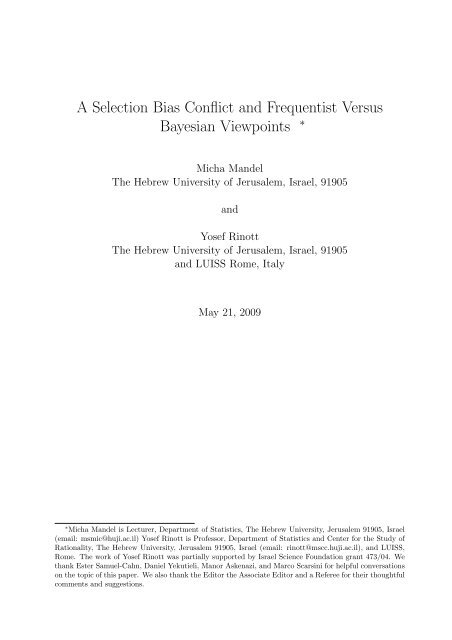
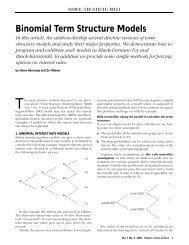
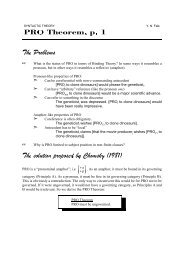
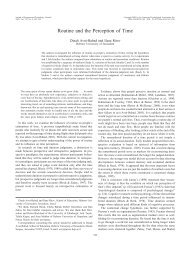
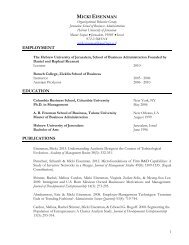
![CV [PDF] - Pluto Huji Ac Il](https://img.yumpu.com/18174585/1/190x245/cv-pdf-pluto-huji-ac-il.jpg?quality=85)
